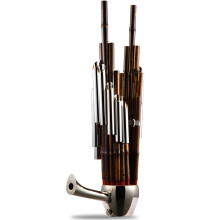Sheng overview
 Sheng (pinyin: shēng) is one of the oldest musical instruments in China. It is the earliest instrument in the world to use free reeds, and it is also the originator of most existing reed instruments in the world.
Sheng (pinyin: shēng) is one of the oldest musical instruments in China. It is the earliest instrument in the world to use free reeds, and it is also the originator of most existing reed instruments in the world.The basic structure of the sheng is to stick the reeds with wax seals on the sheng feet at the lower end of the sheng tube (also called "miao tube" or "sheng miao"), and insert it into the sheng bucket.
There is a finger hole at the lower end of each pipe near the bucket. When playing, press the finger hole at the lower end of the pipe, and blow or inhale through the mouthpiece (also called "咮") to instigate the coupling vibration of the reed and the air column in the pipe to produce sound. The pipe is inlaid with silver wire to identify the pitch.
Chinese sheng and yu were introduced to Japan in the prosperous Tang Dynasty. In the Zhengcangyuan of Todaiji Temple in Nara, there are two Wu bamboo sheng and yu made in the Tang Dynasty in my country, and one false-spotted bamboo sheng and yu, all of which are 17 tubes. , the arrangement method is horseshoe-shaped, only the curved mouthpiece is particularly long, and there are painted figures or landscape paintings on the bucket. In ancient books, the yu is said to be multi-pipe, and the yu used in the Tang folk music stored in Zhengcangyuan has the same 17 pipes as the sheng.
my country's sheng has played a positive role in promoting the development of Western musical instruments.
- Chinese name:Sheng
- Pinyin:shēng
- country of origin:China
- Types of:wind instrument
overview of other similar instruments
- sanyanxiao overview
- Daguangxian overview
- Leiqin overview
- hahao overview
- yandundagu overview
- Han Xiaozheng overview
- Fang Xiang overview
- guanzi overview
- zhuqin (Dao Qin) overview
- zhuiqin overview
- bangzi overview
- three-stringed piano overview
- Gehu overview
- xiao overview
- xiaokonghou overview
- Konghou overview
- Sheng overview
- suona overview
- hulusi overview
- gushao overview
 渝公网安备 50010702504639号
渝公网安备 50010702504639号